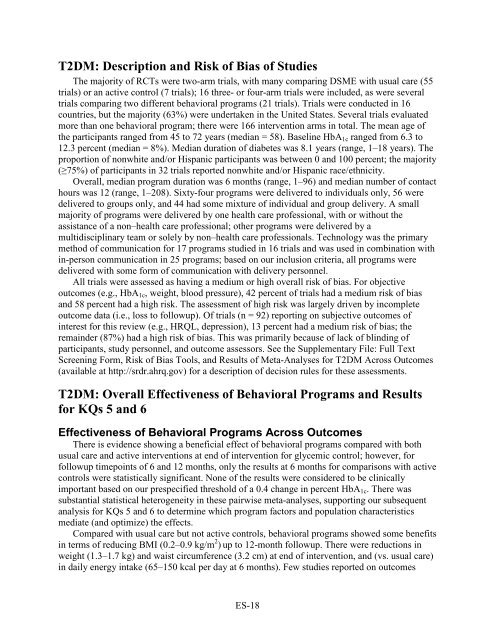Behavioral Programs for Diabetes Mellitus
diabetes-behavior-programs-report-150924
diabetes-behavior-programs-report-150924
- No tags were found...
You also want an ePaper? Increase the reach of your titles
YUMPU automatically turns print PDFs into web optimized ePapers that Google loves.
T2DM: Description and Risk of Bias of Studies<br />
The majority of RCTs were two-arm trials, with many comparing DSME with usual care (55<br />
trials) or an active control (7 trials); 16 three- or four-arm trials were included, as were several<br />
trials comparing two different behavioral programs (21 trials). Trials were conducted in 16<br />
countries, but the majority (63%) were undertaken in the United States. Several trials evaluated<br />
more than one behavioral program; there were 166 intervention arms in total. The mean age of<br />
the participants ranged from 45 to 72 years (median = 58). Baseline HbA 1c ranged from 6.3 to<br />
12.3 percent (median = 8%). Median duration of diabetes was 8.1 years (range, 1–18 years). The<br />
proportion of nonwhite and/or Hispanic participants was between 0 and 100 percent; the majority<br />
(≥75%) of participants in 32 trials reported nonwhite and/or Hispanic race/ethnicity.<br />
Overall, median program duration was 6 months (range, 1–96) and median number of contact<br />
hours was 12 (range, 1–208). Sixty-four programs were delivered to individuals only, 56 were<br />
delivered to groups only, and 44 had some mixture of individual and group delivery. A small<br />
majority of programs were delivered by one health care professional, with or without the<br />
assistance of a non–health care professional; other programs were delivered by a<br />
multidisciplinary team or solely by non–health care professionals. Technology was the primary<br />
method of communication <strong>for</strong> 17 programs studied in 16 trials and was used in combination with<br />
in-person communication in 25 programs; based on our inclusion criteria, all programs were<br />
delivered with some <strong>for</strong>m of communication with delivery personnel.<br />
All trials were assessed as having a medium or high overall risk of bias. For objective<br />
outcomes (e.g., HbA 1c , weight, blood pressure), 42 percent of trials had a medium risk of bias<br />
and 58 percent had a high risk. The assessment of high risk was largely driven by incomplete<br />
outcome data (i.e., loss to followup). Of trials (n = 92) reporting on subjective outcomes of<br />
interest <strong>for</strong> this review (e.g., HRQL, depression), 13 percent had a medium risk of bias; the<br />
remainder (87%) had a high risk of bias. This was primarily because of lack of blinding of<br />
participants, study personnel, and outcome assessors. See the Supplementary File: Full Text<br />
Screening Form, Risk of Bias Tools, and Results of Meta-Analyses <strong>for</strong> T2DM Across Outcomes<br />
(available at http://srdr.ahrq.gov) <strong>for</strong> a description of decision rules <strong>for</strong> these assessments.<br />
T2DM: Overall Effectiveness of <strong>Behavioral</strong> <strong>Programs</strong> and Results<br />
<strong>for</strong> KQs 5 and 6<br />
Effectiveness of <strong>Behavioral</strong> <strong>Programs</strong> Across Outcomes<br />
There is evidence showing a beneficial effect of behavioral programs compared with both<br />
usual care and active interventions at end of intervention <strong>for</strong> glycemic control; however, <strong>for</strong><br />
followup timepoints of 6 and 12 months, only the results at 6 months <strong>for</strong> comparisons with active<br />
controls were statistically significant. None of the results were considered to be clinically<br />
important based on our prespecified threshold of a 0.4 change in percent HbA 1c . There was<br />
substantial statistical heterogeneity in these pairwise meta-analyses, supporting our subsequent<br />
analysis <strong>for</strong> KQs 5 and 6 to determine which program factors and population characteristics<br />
mediate (and optimize) the effects.<br />
Compared with usual care but not active controls, behavioral programs showed some benefits<br />
in terms of reducing BMI (0.2–0.9 kg/m 2 ) up to 12-month followup. There were reductions in<br />
weight (1.3–1.7 kg) and waist circumference (3.2 cm) at end of intervention, and (vs. usual care)<br />
in daily energy intake (65–150 kcal per day at 6 months). Few studies reported on outcomes<br />
ES-18


